This archived website 'Flemish primitives' is temporarily not being updated. Certain functionality (e.g. specific searches in the collection) may no longer be available. News updates about the Flemish primitives will appear on vlaamsekunstcollectie.be. Questions about this website? Please contact us at info@vlaamsekunstcollectie.be.
Museum of the Basilica of the Holy Blood
Museum of the Basilica of the Holy Blood
Highlights of the Collection
Introduction
In the 12th Century, Count Diederick van de Elzas (1128-1168) had a double chapel erected in the Burg in Bruges. Inside, he installed the Saint Basil Chapel, above which came the Basilica of the Holy Blood. The Saint Basil Chapel is the only Romanesque church building in West Flanders that has been as good as fully preserved. The chapel is dedicated to Saint Basil the Great, a 4th-century Greek Church instructor. Count Robrecht II brought his relics from Cesarea (Turkey) back with him to Bruges. Diederick and his son Philip van de Elzas (1142-1191), Count of Flanders used the structure as a family chapel. Their residency, Het Steen, since gone, was adjacent to the double chapel.
The upper chapel was also originally built in the Romanesque style but underwent various architectural changes. Due to the consequences of the French Revolution, the building complex suffered heavy damage from 1792 onwards. The building was in a state of disrepair, and important pieces were scrapped at the beginning of the 19th Century. During a long and complex renovation and restoration campaign during the 19th Century, characterised by changing plans and building foremen, the complex received a Neo-Gothic makeover on both the exterior and within the interior. Only the Saint Basil Chapel retains its Romanesque interior.
Beginning in 1889, a concierge and a museum were built in Neo-Bruges style after the design of architect Louis Delacenserie (1838-1909). The collection of the Holy Blood grew organically and is especially varied and consists of paintings, sculptures, manuscripts, precious jewelry, glass windows and lacework. Below are found early pieces (15th, 16th and 17th Centuries), but the centuries following as well as the 19th-century Gothic Revival are also represented in the collection.
Master of the Saint Barbara Legend, Scenes from the Life of Saint Barbara (Oil painting on panel, 73 cm x 62 cm.)
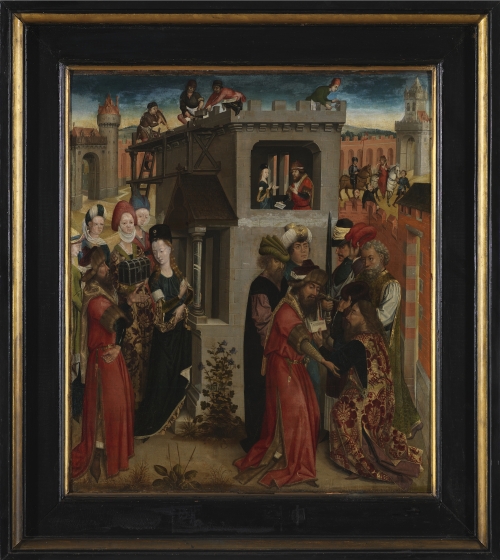
This painting is the eponymous work (chief work in the oeuvre, after which the anonymous artist (or group of artists) was named), which once formed the middle panel of a tableaux along with a noticeably larger measuring fragment that is preserved in the Royal Museums of Fine Arts of Belgium in Brussels (KMSKB).
The German Art Historian Max Friedländer (1867-1958) coined this provisional name in 1924. The anonymous master worked between 1470 and 1500 in Brussels. He is seen as the follower of Rogier van der Weyden, not as a slavish copyist. Further research exposed two different hands, which makes the attribution more problematic. Via archival research, an attempt was undertaken to unmask the anonymous artist. Researchers developed the hypothesis that it was the work of Aert van den Bossche. Van den Bossche was active in Brussels, but was also a member of the Saint Luke guild of Bruges. For this relationship, see the research of Art Historians Véronique Bücken and Griet Steyaert in the catalog introduction of the exhibition, The Heritage of Rogier van der Weyden (2013) in the KMSKB.
Sixteen scenes from the life of Saint Barbara of Nicodemus are depicted on the two panels. On the Bruges piece we see how the tower, in which Barbara was locked up by her father Dioscorus, is an annex. Dioscorus wanted to keep his daughter fearfully hidden away from men. Barbara, who converted to Christianity, inscribed a sign of the Cross in a marble pillar. In the Brussels piece, Barbara is baptised by John, and barely escaping the sword of her father, she ultimately appeared before the judge. Saint Barbara was tortured during her life and was robbed of her life by her father. The most well-known depiction of Saint Barbara in the collection of the Flemish Art Collection is Jan van Eyck's rendering from the collection of the Royal Museum of Fine Arts in Antwerp (KMSKA).
Master of the Holy Blood, The Lamentation of Christ (Oil painting on panel, 101,5 cm x 70 cm).
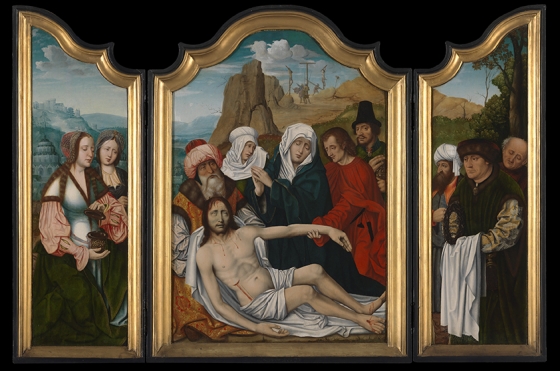
The triptych of The Lamentation of Christ is by the hand of the Master of the Holy Blood. The byname of the Master of the Holy Blood is based upon the preservation place of the triptych. There is precious little known about the anonymous master. Around 1520-25, he worked in Bruges, but probably first received training in Antwerp, in the artistic milieu of Quinten Massijs (1466-1530). The Antwerp influence is found again in The Lamentation of Christ, in which the middle panel is loosely based on Massijs' Altarpiece of the Guild of the Joiners (1509-1511, KMSKA), both compositionally as well as the group of figures.
One of the most important works of this master, The Adoration of the Holy Virgin is found in the Saint Jacob's Church in Bruges. The attribution of works to the master occurred primarily on the basis of this triptych. The work varies considerably in style from The Lamentation, which led to the fact that two stylistic groups of works in the oeuvre of the Master of the Holy Blood are distinguished.
Other works in the collections of the Flemish Art Collection:
- Madonna with Angels
- Madonna with the Saints Catherine and Barbara
- Scenes of the Apocalypse and the Annunciation
- Online publication concerning Scenes of the Apocalypse and the Annunciation
Pieter Pourbus, Two Panels with the Portraits of the Members of the Fraternity of the Holy Blood, 1556 (Oil painting on panel, 113,5 cm x 83,5 cm)
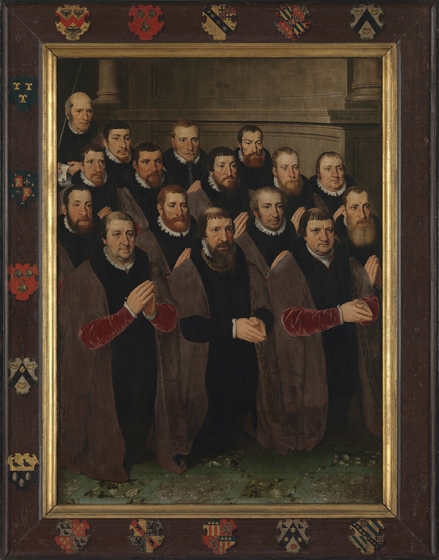
Pieter Pourbus (1523/24-1584), an artist who came from the Northern Netherlands, is seen as the most important Bruges painter in the second half of the 16th Century. He was, in the spirit of the Renaissance, a true all-rounder: painter, draftsman, cartographer, land surveyor and engineer. He is the teacher of his son Frans Pourbus (I) and his grandson Frans Pourbus (II).
Pourbus was an outstanding portrait artist. This is apparent from the two panels with the portraits of the members of the Fraternity of the Holy Blood from 1556. The two panels were originally the side panels of a polyptych that adorned the main altar of the Holy Blood Chapel. They formed the lower register of the polyptych, from which the central panel is lost. The uppermost central panel, The Marriage of Cana (1519) with the patron Jan de Sedano by Gerard David, is preserved in the Louvre in Paris.
The two panels contain group portraits of 32 of the members of the Fraternity. The portraits are painted in high realism and individually rendered. All of them are known by name thanks to the member's register and the coats of arms on the registers. They are stylistically free, symmetrically grouped and are placed in a Renaissance architectural setting. Many have declared these panels of Pourbus to be masterpieces, primarily due to the realism of the individual figures. The portraits were influential amongst the Bruges painters.
Selection of works by Pourbus in the collections of the VKC:
- Portrait of Jan van Eyewerve
- Portrait of Jacquemyne Buuck
- Last Judgement
- Last Supper
- Plan of the Abbey of the Dunes at Koksijde
Wool wall tapestry, 1637 (260 cm x 530 cm)
The wool tapestry from 1637 is the largest piece in the collection and originates from the abolished Eeckhout Abbey. It depicts the transport of the relics of Saint Augustine. According to the tradition, the body of Saint Augustine, which was brought from Africa to Sardinia, was carried to Pavia. In this representation, the body is taken by procession to the Eeckhout Abbey. The city view of Bruges is a unique feature as it appears presented on a tapestry. The towers of the Saint Salvator Cathedral (without the Neo-Romanesque addition of Chantrell), from the Church of Our Lady and from the Belfort are clearly recognisable.
The identity of the executor of the drawing with the design for the tapestry has left people in the dark, but it undoubtedly comes from a studio in Bruges. The tapestry is of very good quality and bears the coat of arms from the former Eeckhout Abbey and the Abbot Nicolaas van Troostenberghe. The piece is not only dated, but also displays two city markings of the Bruges tapestry weavers (the crowned Gothic ‘b' and the weaver's spool), as well as the initials IDR of the Bruges weaver Jan de Ruddere.
Perhaps the tapestry was gifted by Joseph van Huerne to the Holy Blood. The benefactor Van Huerne was a member of the fraternity. Among other things, he gifted the very important image of Mary in the lower chapel (Sedas Sapientiae from the early 14th Century) and the copper half-reliefs from 1530.
Shrine with crystal relic cylinder of the Holy Blood, 1617 (Gold, gilded silver, precious stones, enamel)
The eye-catcher of the treasury is the shrine with the crystal relic cylinder of the Holy Blood. It is made in gold and gilded silver and is adorned with precious stones, semi-precious stones, cameos, pearls and coloured enamel. The shrine dates from 1617 and is by the hand of Jan Crabbe, a Bruges silversmith. It displays a Renaissance structure, a delicate construction, chiseled and decorated with figurines, jewels, coats of arms, and the motif of the pelican. The pelican, who tears open its breast to feed its young is a symbol of the Holy Blood. For a long time, the so-called coronet of Mary of Burgundy (15th Century) was exhibited in the shrine. Today, it is displayed separately.
Pareerkeers, 1529
The so-called ‘pareerkeers' (a candle) was carried during the Holy Blood procession and dates from 1529. The acquisition was made possible with gifts collected by the means of the King Baudouin Foundation. An inscription on an old photo in the archive of the fraternity shows that the piece belonged to a bailiff that lived in the Meestraat in 1912 and that he had gotten it from his grandmother. At that point it was already in the family for at least eighty years. Is this the pareerkeers that is mentioned in 1544 in the city ledgers (preserved in the city archive)? A certain H. Glasencamp (woodcarver) restores a pareerkeers, which was designed by Lanceloot Blondeel (1498-1561), the father-in-law of Pieter Pourbus.
Already in 1449 pareerkeers were carried about in the procession. The first regulations of the fraternity mentions the following decision of the General Assembly: "the last 4 admitted members shall bear a pareerkeers in the Procession with the image by Diederick van den Elzas, Count of Flanders, who received the Holy Blood from the hands of the Patriarch of Jerusalem, with the pelican that feeds her young with her blood". The object was ringed with a crown of thorns on which "vaentjens" were attached with the coats of arms of the Noble Brothers.
Manuscript Processionale, 16th-17th Century
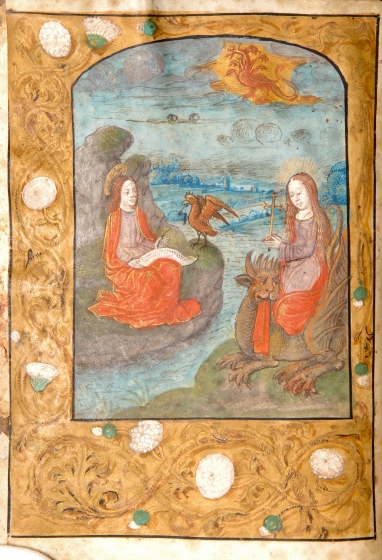
The so-called Processionale is a liturgical hymnal with the hymns that were sung during the Holy Blood Procession. It was made over a period of more than a century, from the early 16th Century to the 17th Century. The miniatures and the decorations are made in the Ghent-Bruges style. Some names are also mentioned, among others, those of Bruges nuns and that of a monk from the Saint Andrews Abbey.
Manuscript Parurenboek
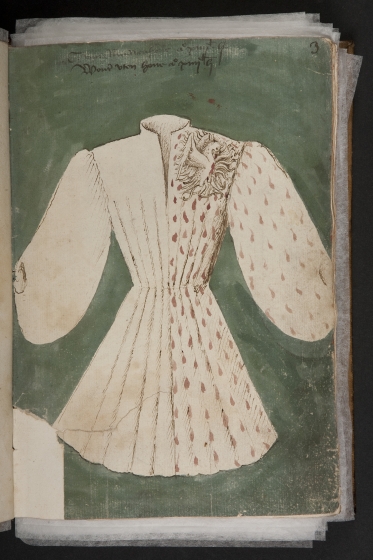
In 1759, the manuscript was taken over from an older parurenboek from the end of the 15th Century, which was completed in 1518. It contains a list of the toasts. Many pages are accompanied by watercolour drawings that show the paruren (ceremonial garment) of the toasts, and in large part agree with present-day gowns.
Stained glass windows
The Holy Blood is in possession of stained glass windows: glasswork form the chapel, and 72 stained glass panels and windows in the treasury. Some fragments come from the Holy Blood itself, and others were gifted by Joseph Van Huerne. The majority of glass dates from the 15th and 16th Centuries.
Dominique Marechal (Curator at the Royal Museums of Fine Arts of Belgium in Brussels)
(Edited by: Matthias Depoorter)







